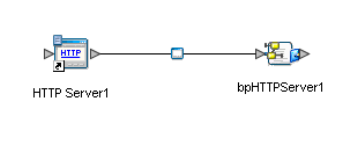
Chapter 6 Section 6.6
Implementing the HTTPS eWay BPEL Sample Projects Building and Deploying the prjHTTPServer_BPEL Sample Project
HTTPS eWay Adapter User’s Guide 91 Sun Microsystems, Inc.
Populating the Connectivity Map
Add the Project components to the Connectivity Map by dragging the icons from the
toolbar to the canvas. This operation creates the components for you.
For this sample Project, drag and drop the following components onto the Connectivity
Map canvas.
One Service
HTTPS eWay/server external application
Figure 44 shows the components in the Connectivity Map.
Figure 44 Connectivity Map With Components: prjHTTPServer_BPEL
1 Rename the Service1 component to bpHTTPServer1.
2 Rename the HTTPS external application HTTPServer1.
Be sure to save the new Connectivity Map before you proceed. You can click Save
for this purpose.
Defining the Business Process
Define your Business Process by combining the Business Process icon with the Service
icon in the Connectivity Map. To do so, drag and drop the bpHTTPServer icon from
the Project Explorer tree onto the Connectivity Map’s bpHTTPServer1 Service icon. If
the operation is successfully defined, the gears on the bpHTTPServer1 icon change
from red to yellow.
Binding the eWay Components
The final step in creating a Connectivity Map is binding the eWay components together.
Steps required to bind eWay components together:
1 Open the cmHTTPServer Connectivity Map and double-click the HttpServer1
Business Process. The HttpServer1 Binding dialog box appears.
2 From the HttpServer1 Binding dialog box, map HTTPSender (under Implemented
Services) to the HTTPServer1 External Application. To do this, click on
HTTPSender in the HttpServer1 Binding dialog box, and drag the cursor to the
HTTPServer1 External Application in the Connectivity Map. A link is now visible
between HTTPServer1 and HttpServer1, as seen in Figure 45.
